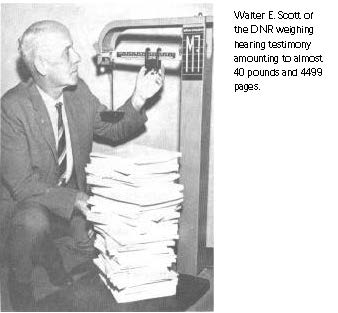DDT on Trial in Madison
The decisive battle in the DDT war began with a hearing instigated by the indomitable “Prairie Lady,” Lorrie Otto, and brought on by a petition of the Citizens Natural Resources Association (CNRA) to have DDT declared an “environmental pollutant” by the Wisconsin Department of Natural Resources. The hearings opened in the Wisconsin State Capital Chamber on December 2, 1968 adjourned on May 21, 1969, nearly six months after they had begun and eventually leading to a decision declaring DDT a pollutant in August 1969. and a ban on the use of DDT in Wisconsin— 27 days of testimony from 32 witnesses who considered 208 exhibits and filled nearly 4500 pages of trial transcripts memorializing the epic courtroom confrontation.
Portions of those hearings have had lasting significance in science and in Anglo-American common law. There was trail blazing precedent-setting legal action, particularly with respect to trial strategy, cross-examination, and the way much of the breakthrough science was both developed and presented.
As a result of their preparation for and testimony during the Wisconsin DDT hearings, biochemist Robert Risebrough made significant advances in the analytical chemistry of environmental samples, particularly chemical analysis of animal tissues. Environmental Systems Science was created during the last week of the hearings in the spring of 1969 through the testimony of ecologist Orie Loucks who presented a seminal paper, “Systems Studies of DDT Transport” which was eventually published in the prestigious journal Science.

40 pounds of trial Transcript
Other than the actual transcripts of testimony at the hearings and the daily newspaper reports filed by Whitney Gould of the Madison Capital Times and intermittent reports in other newspapers such as the New York Times, as well as live television coverage from ABC news, the primary contemporaneous sources for the Madison DDT hearings outside of the actual transcripts of those hearings are The Environment, The Establishment, & the Law, by Harman Henkin who covered the hearings on a daily basis for the Baltimore Sun and James Staples of the Newark Star-Ledger who also covered the hearings on a daily basis together with Martin J. Merta, son of the legendary news photographer Frank J. Merta, who was the custodian of all the documents at the time the book was written and provided access to the reporters so they were able to augment their personal notes; together with an article in the Wisconsin Journal of History by Thomas Dunlap, a graduate student who attended the hearings and later became the first to earn a PhD in Environmental History. He later expanded his Journal paper into a book.
